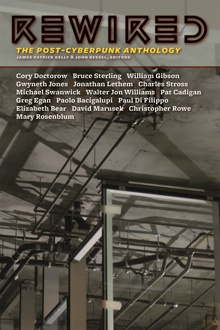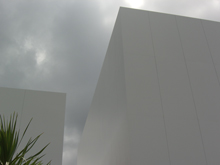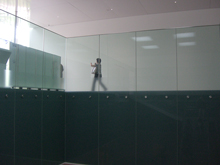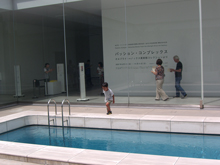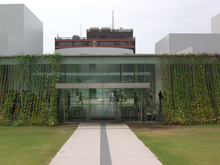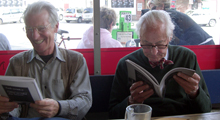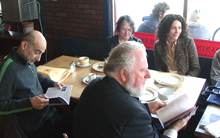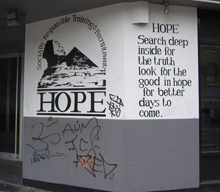In August we visited Kanazawa, an old city on the Sea of Japan, where there’s a ruined castle, one of the three most celebrated gardens in Japan, and the brand-new, opened-in-February 21st Century Museum of Contemporary Art.
What got my attention was the museum. It’s circular in plan, with four entrances; there’s no “front,” and the museum’s spaces comprise a cavalcade of rooms, corridors, and open courtyards, all of them of different sizes, shapes, and even heights. It’s the most amazing interpenetration of outside and inside, public space and private space, that I’ve ever seen. The art was pretty good, too, but it was the museum itself that I’m glad I saw.
One of the permanent installations is the James Turrell Room, a huge square room like a Roman pluvium: open to the sky in the middle, with stone walls and bench seats and a stone floor with subtle, nearly invisible drainage for the runoff when it rains. And it did rain. When I first went into the Turrell Room, it was a humid, pre-storm day; the clouds ran overhead on the wind, with patches of blue sky appearing and disappearing behind them, and the air in the room was intensely humid. (So was the world outside.) A little while later, when I dragged Eileen and Ellen Datlow back to see the Turrell Room, it had rained; the floor was wet, and a light after-storm sprinkle still fell through the wide square opening in the roof. In typical James Turrell style, extremely subtle banks of lights glowed behind the backs of the side-benches, tinting the walls a slowly-changing range of pastels, which added to the luminous effect. It was a peculiar form of site-specific magic.
One of the two current exhibits was created for the Kanazawa museum, although the artist was from the UK: Grayson Perry’s “My Civilization” presents a kaleidoscopic overview of Perry’s transgressive work, in a form created expressly for this venue. The show opened in Kanazawa, and only later would it head off to London. While Perry’s drawing and ceramic skills impressed me, and he struck me as a wonderfully disruptive kind of artist, it remained the museum itself that pleased me more than any of the art within it.
The interior spaces vary in height and shape and purpose; they’re intertwined with corridors and courtyards that are open to the air – and sometimes to the public, who otherwise have to pay an admission fee for the main exhibits. That interpenetration is at the heart of the Kanazawa museum: literally as well as intellectually.
The museum even uses a schematic of its circular layout as its logo. At the museum shop, I picked up a nicely patterned orange-and-white neck cloth (one of those necessities of Japan’s hot, humid summers) with the logo worked into its design; it served me well, both practically and as an image of the museum, until I left it on the Gatwick Express, three weeks later and a world away.
Although Kanazawa has a long history, establishing a cutting edge art museum there is probably a bit like creating, say, a Spokane Museum of Contemporary Art, and endowing it with a huge budget and a global mission. (Not that I wouldn’t be happy to see such a thing.) It appeals to my anti-metropolitan bias, though my equally strong metropolitan bias just shakes its head. I applaud what looks to me like a heroic effort, and I’m glad to have had the chance to walk through this museum only months after its opening, before some of my Japanese acquaintances have even had a chance to visit it
Categorized as architecture, culture, design |




